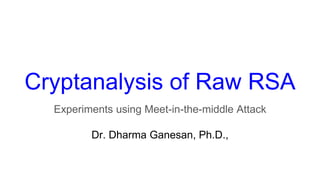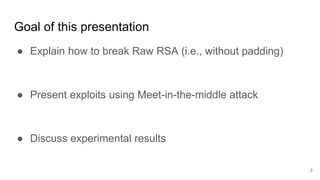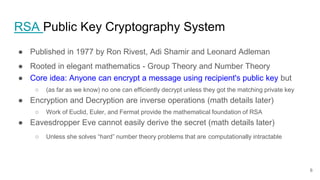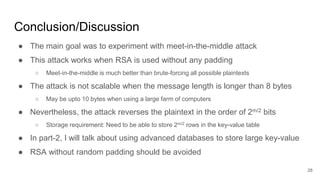The document presents a detailed analysis of breaking raw RSA encryption through a meet-in-the-middle attack. It explains the RSA cryptography system, its key generation, and the mechanics behind the chosen plaintext and the meet-in-the-middle attacks. The results demonstrate that the attack is effective for small message sizes without padding, but struggles with larger lengths, emphasizing the need for padding in secure cryptographic practices.










![Raw RSA (in Java)
public static byte[] encrypt(PublicKey pubKey, String message) throws Exception
{
Cipher cipher = Cipher.getInstance("RSA/ECB/NOPADDING");
cipher.init(Cipher.ENCRYPT_MODE, pubKey);
return cipher.doFinal(message.getBytes());
}
11](https://image.slidesharecdn.com/rsawithoutpadding-180528163026/85/RSA-without-Padding-11-320.jpg)
![Deterministic behavior of Raw RSA (simple demo)
12
public class RSA_Encrypt {
public static void main(String [] args) throws Exception {
if(args.length != 3) {
System.out.println("Usage: RSA_Encrypt <modulus n> <exponent e> <plaintext>");
System.exit(-1);
}
BigInteger n = new BigInteger(args[0]);
BigInteger e = new BigInteger(args[1]);
String plaintext = args[2];
PublicKey pubKey = RSAService.getPublicKey(n, e);
byte[] ciphertext = RSAService.encrypt(pubKey, plaintext);
System.out.println(javax.xml.bind.DatatypeConverter.printHexBinary(ciphertext));
}
}](https://image.slidesharecdn.com/rsawithoutpadding-180528163026/85/RSA-without-Padding-12-320.jpg)







![Implementation Details: Key-Value Store
(Hashtable)public interface IKeyValueStore {
public void put(byte[] key, byte[] data);
public byte[] get(byte[] key);
public void close();
}
20
● This interface provides an abstraction of hashtable implementations
● Allows plug-and-play of different key-value pair libraries](https://image.slidesharecdn.com/rsawithoutpadding-180528163026/85/RSA-without-Padding-20-320.jpg)
![Key-Value Implementation using Java Hashmap
public class KeyValueStoreHash implements IKeyValueStore {
private HashMap<ByteBuffer, byte[]> hashMap = new HashMap<ByteBuffer, byte[]>();
public KeyValueStoreHash() {
}
public void put(byte[] key, byte[] data) {
hashMap.put(ByteBuffer.wrap(key), data);
}
public byte[] get(byte[] key) {
return hashMap.get(ByteBuffer.wrap(key));
}
public void close() {
hashMap.clear();
}
} 21](https://image.slidesharecdn.com/rsawithoutpadding-180528163026/85/RSA-without-Padding-21-320.jpg)
![Step 1: Hashtable construction (basic version)
public void buildHashTable() {
BigInteger two = BigInteger.valueOf(2);
BigInteger minM1 = two.pow(minNumBitsM1 - 1);
BigInteger maxM1 = two.pow(maxNumBitsM1);
for(BigInteger m1 = minM1; m1.compareTo(maxM1) < 0; m1 = m1.add(BigInteger.ONE)) {
byte[] m1PowE = m1.modPow(e, n).toByteArray();
keyValueStore.put(m1PowE, m1.toByteArray());
}
}
22](https://image.slidesharecdn.com/rsawithoutpadding-180528163026/85/RSA-without-Padding-22-320.jpg)
![Step 2: Search the hashtable for a match
public BigInteger breakRSA(BigInteger c) {
BigInteger m = BigInteger.ZERO;
BigInteger two = BigInteger.valueOf(2);
BigInteger minM2 = two.pow(minNumBitsM2 - 1);
BigInteger maxM2 = two.pow(maxNumBitsM2);
for(BigInteger m2 = minM2; m2.compareTo(maxM2) < 0; m2 = m2.add(BigInteger.ONE)) {
BigInteger m2powe = m2.modPow(e, n);
byte[] lhs = c.multiply(m2powe.modInverse(n)).mod(n).toByteArray();
if(keyValueStore.get(lhs) != null) {
BigInteger m1 = new BigInteger(keyValueStore.get(lhs));
m = m1.multiply(m2);
System.out.println("Match m = " + m + " m1 = " + m1 + " m2 = " + m2);
break;
}
}
return m;
}
23](https://image.slidesharecdn.com/rsawithoutpadding-180528163026/85/RSA-without-Padding-23-320.jpg)





